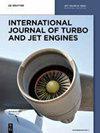Probabilistic analysis of maximum mode shape for mistuned blisk
IF 0.9
4区 工程技术
Q4 ENGINEERING, AEROSPACE
引用次数: 0
Abstract
Abstract The high-fidelity finite element model (HFFEM) and Monte Carlo (MC) simulation of the blisk involve large number of calculations, which leads to low computational efficiency. In this case, an improved quasi-static mode compensation method (IQSMCM) and quadratic function-extremum response surface method (QF-ERSM) are proposed to investigate the probability distribution of mistuned blisk based on its vibration characteristics. The number of nodes and elements of IQSMCM relative to HFFEM are, respectively, reduced by 79.66 and 80.03%. Thus, the degrees of freedoms (DOFs) of IQSMCM are obviously reduced compared with that of HFFEM, and its computational efficiency is obviously increased. The maximum displacement shape (MDS) is investigated via IQSMCM. The computational efficiency is enhanced in the condition of ensuring the computational accuracy. Based on the investigation of maximum mode shape, the probability analysis is performed via QF-ERSM. The computational accuracy of QF-ERSM is improved by 93.80% compared with that of MC. Furthermore, the computational efficiency of QF-ERSM is higher 57.06% than that of QF-RSM. The sample history, extremum response surface function, sample history and distribution histogram of MDS are obtained via QF-ERSM, which provides an important guidance for the reliability research of the mistuned blisk. This research can be applied not only to aeroengine’s blisk but also to other large and complex mechanical structures in practical engineering.失谐叶盘最大振型的概率分析
摘要:飞盘的高保真有限元模型(HFFEM)和蒙特卡罗模拟(MC)涉及大量的计算,导致计算效率低。针对这种情况,提出了一种改进的准静态模式补偿方法(IQSMCM)和二次函数极值响应面法(QF-ERSM),根据其振动特性研究失谐圆盘的概率分布。与HFFEM相比,IQSMCM的节点数和元素数分别减少了79.66%和80.03%。因此,与HFFEM相比,IQSMCM的自由度明显降低,计算效率明显提高。利用IQSMCM对最大位移形状(MDS)进行了研究。在保证计算精度的前提下,提高了计算效率。在研究最大振型的基础上,利用QF-ERSM进行了概率分析。QF-ERSM的计算精度比MC提高了93.80%,计算效率比QF-RSM提高了57.06%。通过QF-ERSM获得了MDS的样本历史、极值响应面函数、样本历史和分布直方图,为失谐圆盘的可靠性研究提供了重要的指导。该研究不仅可以应用于航空发动机叶片,还可以应用于实际工程中其他大型复杂机械结构。
本文章由计算机程序翻译,如有差异,请以英文原文为准。
求助全文
约1分钟内获得全文
求助全文
来源期刊

International Journal of Turbo & Jet-Engines
工程技术-工程:宇航
CiteScore
1.90
自引率
11.10%
发文量
36
审稿时长
6 months
期刊介绍:
The Main aim and scope of this Journal is to help improve each separate components R&D and superimpose separated results to get integrated systems by striving to reach the overall advanced design and benefits by integrating: (a) Physics, Aero, and Stealth Thermodynamics in simulations by flying unmanned or manned prototypes supported by integrated Computer Simulations based on: (b) Component R&D of: (i) Turbo and Jet-Engines, (ii) Airframe, (iii) Helmet-Aiming-Systems and Ammunition based on: (c) Anticipated New Programs Missions based on (d) IMPROVED RELIABILITY, DURABILITY, ECONOMICS, TACTICS, STRATEGIES and EDUCATION in both the civil and military domains of Turbo and Jet Engines.
The International Journal of Turbo & Jet Engines is devoted to cutting edge research in theory and design of propagation of jet aircraft. It serves as an international publication organ for new ideas, insights and results from industry and academic research on thermodynamics, combustion, behavior of related materials at high temperatures, turbine and engine design, thrust vectoring and flight control as well as energy and environmental issues.
 求助内容:
求助内容: 应助结果提醒方式:
应助结果提醒方式:


